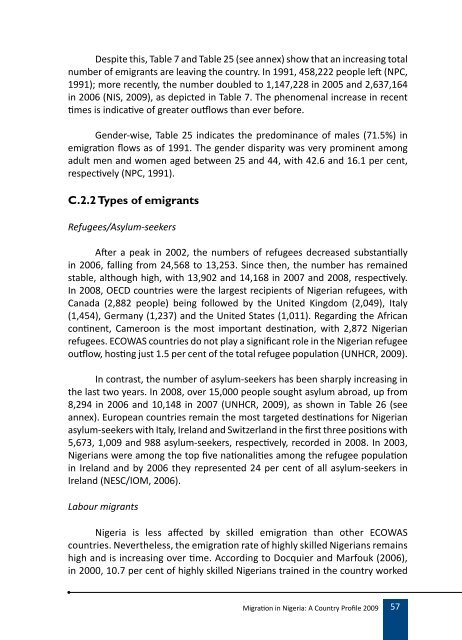Migration Profile on Nigeria - IOM Publications - International ...
Migration Profile on Nigeria - IOM Publications - International ...
Migration Profile on Nigeria - IOM Publications - International ...
Create successful ePaper yourself
Turn your PDF publications into a flip-book with our unique Google optimized e-Paper software.
Despite this, Table 7 and Table 25 (see annex) show that an increasing total<br />
number of emigrants are leaving the country. In 1991, 458,222 people left (NPC,<br />
1991); more recently, the number doubled to 1,147,228 in 2005 and 2,637,164<br />
in 2006 (NIS, 2009), as depicted in Table 7. The phenomenal increase in recent<br />
times is indicative of greater outflows than ever before.<br />
Gender-wise, Table 25 indicates the predominance of males (71.5%) in<br />
emigrati<strong>on</strong> flows as of 1991. The gender disparity was very prominent am<strong>on</strong>g<br />
adult men and women aged between 25 and 44, with 42.6 and 16.1 per cent,<br />
respectively (NPC, 1991).<br />
c.2.2 Types of emigrants<br />
Refugees/Asylum-seekers<br />
After a peak in 2002, the numbers of refugees decreased substantially<br />
in 2006, falling from 24,568 to 13,253. Since then, the number has remained<br />
stable, although high, with 13,902 and 14,168 in 2007 and 2008, respectively.<br />
In 2008, OECD countries were the largest recipients of <strong>Nigeria</strong>n refugees, with<br />
Canada (2,882 people) being followed by the United Kingdom (2,049), Italy<br />
(1,454), Germany (1,237) and the United States (1,011). Regarding the African<br />
c<strong>on</strong>tinent, Camero<strong>on</strong> is the most important destinati<strong>on</strong>, with 2,872 <strong>Nigeria</strong>n<br />
refugees. ECOWAS countries do not play a significant role in the <strong>Nigeria</strong>n refugee<br />
outflow, hosting just 1.5 per cent of the total refugee populati<strong>on</strong> (UNHCR, 2009).<br />
In c<strong>on</strong>trast, the number of asylum-seekers has been sharply increasing in<br />
the last two years. In 2008, over 15,000 people sought asylum abroad, up from<br />
8,294 in 2006 and 10,148 in 2007 (UNHCR, 2009), as shown in Table 26 (see<br />
annex). European countries remain the most targeted destinati<strong>on</strong>s for <strong>Nigeria</strong>n<br />
asylum-seekers with Italy, Ireland and Switzerland in the first three positi<strong>on</strong>s with<br />
5,673, 1,009 and 988 asylum-seekers, respectively, recorded in 2008. In 2003,<br />
<strong>Nigeria</strong>ns were am<strong>on</strong>g the top five nati<strong>on</strong>alities am<strong>on</strong>g the refugee populati<strong>on</strong><br />
in Ireland and by 2006 they represented 24 per cent of all asylum-seekers in<br />
Ireland (NESC/<strong>IOM</strong>, 2006).<br />
Labour migrants<br />
<strong>Nigeria</strong> is less affected by skilled emigrati<strong>on</strong> than other ECOWAS<br />
countries. Nevertheless, the emigrati<strong>on</strong> rate of highly skilled <strong>Nigeria</strong>ns remains<br />
high and is increasing over time. According to Docquier and Marfouk (2006),<br />
in 2000, 10.7 per cent of highly skilled <strong>Nigeria</strong>ns trained in the country worked<br />
<str<strong>on</strong>g>Migrati<strong>on</strong></str<strong>on</strong>g> in <strong>Nigeria</strong>: A Country <str<strong>on</strong>g>Profile</str<strong>on</strong>g> 2009<br />
57

















